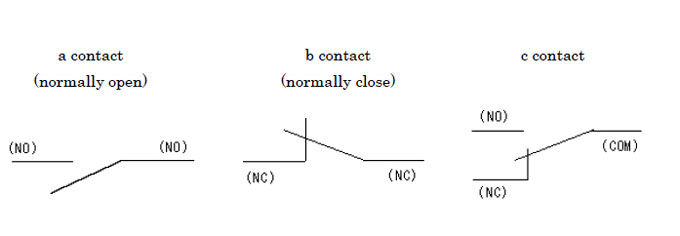Question
What relation is there between NO, NC, COM contact terminals and contact structures of the contact point a, b, c?
Answer
NO terminal, NC terminal and COM terminal represent contact terminals' symbols. Each symbol means a single terminal itself: Normally Open terminal, Normally Closed terminal and Common terminal respectively.
On the other hand, contact point a, contact point b and contact point c represent contact structures. Each means the combination of two contact terminals or more, and is also described as Make contact point, Break contact point and Transfer contact point respectively. When the contact structure has a single combination of the contact point a, it is called contact point 1a, and when it has two combinations of the contact point a, it is called contact point 2a.
Regarding the relation between contact terminals and contact structures, the contact point a is composed of two NO terminals, the contact point b is composed of two NC terminals, and the contact point c is composed of a single NO, NC and COM terminal. Therefore, the contact point 1c can be used as either contact point 1a or contact point 1b, but cannot be used as contact point 1a1b. This is because the contact point 1c has a COM terminal on one side, and thus it cannot be separated.
Sometimes the contact point a is called NO contact point, and the contact point b is called NC contact point, however, the JIS C 0301 Graphical Symbols for Diagrams prescribes them as contact point a and contact point b respectively.
Refer to the following diagrams which describe the contact point symbols conforming to the JIS C0301 Series 1. Be aware that such symbols as "NO" are not included in the contact point symbols, but are shown just for purposes of illustration.



